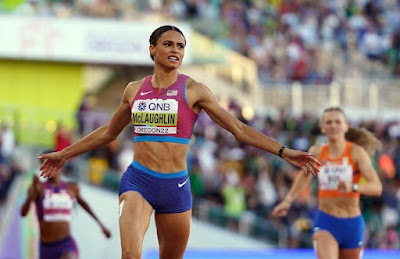Before we talk about the record, let’s just talk about the way 400-meter hurdler Sydney McLaughlin runs. The 400-meter dash, one lap around the track sans hurdles, is sometimes described as the longest sprint, one where runners generally do not mediate their pace, going all out from the starting blocks which is what leads to those agonizing final meters where it looks as if the runners have been dipped in molasses or saddled with an invisible grand piano tied to one leg, hitting an invisible wall and trying to push through. Now, imagine you take the 400-meter dash but then space ten hurdles around the track, the longest sprint but with literal physical obstacles that must be hurdled, including toward the end, meaning you are negotiating 30-inch impediments...while moving through make-believe molasses and dragging an invisible piano behind you. The race is designed to erase grace and induce agony. Sydney McLaughlin, though, is an illusionist as much as a sprinter, bending the race’s designs and making it seem effortless, almost casual.
Much of her mastery stems from her stride, shortened to a more efficient 14 strides from a typical 15, a reminder of how running can be equated with science, and how much math can be involved in these races beyond the finishing time. It’s not just the math, though, it’s the way McLaughlin manifests that math. The language in which God has written the universe, some dude called Galileo deemed mathematics, and for me, someone who sometimes struggles to comprehend that language or even find it remotely interesting in the first place, Sydney McLaughlin, Greatest Athlete in the World, transforms math into poetry and makes efficiency, the worst of all buzzwords, electrifying.
---------------
Ok. Now let’s talk about the record. 50.68. Because consider, that in a sport where tenths of a second function like epochs, over the course of 33 years from 1986 to 2019 the Women’s 400-meter hurdle world record was set but five times by four women, lowered a grand total of .78 seconds from 52.94 to 52.16. Then, in a 13-month span, June 2021 to July 2022, Sydney McLaughlin lowered the world record four times, carving 1.48 seconds off the previous record along the way, very nearly doubling all on her own the reduced time of the previous three decades, culminating in that majestic 50.68 at the just-concluded Athletics World Championships in Eugene, Oregon. And that if that is all too much statistical white noise, consider the sound I made when she crossed the finish line, kind of a non-liquid spit take, this Whaaaaaaaa? emanating from deep within me mixed with an incredulous laugh all emitted as an indefinable sonic blob of absolute bewilderment. Speechless, I think they call it.
50.68. She eclipsed not only the 52-second barrier, independently head-spinning, but then just went right ahead and eclipsed the 51-second barrier too, which is not just head-spinning but unfathomable, like if Lindbergh had reached Paris after crossing the Atlantic, shrugged at his winnowing gas tank, and somehow pressed on to Terra Australis Incognita.
50.68. It’s been compared to Bob Beamon, the American long jumper who in 1968 incomprehensibly boosted the event’s world record by very nearly two feet. That was evolution at ludicrous speed, calculated as an 84-year advance in one leap. I have not seen such calculations with McLaughlin’s run, but what she has done is different anyway. Beamon’s jump was madness in so much as that much progress in one fell swoop was unreasonable - nay, beyond reason - and made that much more so because Beamon never approached the distance again, in retrospect one baffling bolt from the blue. McLaughlin, though, gradually reoriented the frontier of what was possible with each successive race, her previous three world records mere foreshocks to The Big One. Her madness was methodical.
50.68. When Michael Johnson ripped off his eye-popping 19.32 200-meter world record at the 1996 Atlanta Summer Olympics, lowering a world record that had only been lowered once in 17 years by over half-a-second, his competitor Ato Boldon marveled that 19.32 was a date, not a time, a neat encapsulation of its disorienting nature. But, 50.68? That’s neither a time nor a date. What on earth is it? Maybe viewing it merely as a number is our mistake. Maybe we need to view it in terms of numerology. ifate, the self-proclaimed #1 site for astrology for 2007, says that “from a numerological standpoint, the energy surrounding the four-digit number 5068 is a notably assertive energy…and marked vibrations of creative energy. It’s a number that rises high above others with its eternal desire for victory.” Pseudoscience? Pfffft. McLaughlin’s 50.68 is the proof.
The immediate question in its aftermath was how much faster can she go, or whether she might attempt the unprecedented 400-meter / 400-meter hurdles double at the Paris Olympics in 2024, or if she might even just specialize in the 400 itself and go for the (in all likelihood GDR-anabolic steroid sponsored) world record that has stood since 1985. I understand the temptation, to look past the horizon just crossed for the next one. When someone asked Michael Johnson’s coach Clyde Hart in that 19.32 aftermath how long the record might stand, Hart queried “When does Michael run again?” But Johnson never surpassed 19.32. Running that fast is arduous; breaking records is hard; windows close quicker than you think. In those glory days of Usain Bolt, I tended to watch his races with eye on the clock, putting great expectations before simply experiencing greatness. I will not make that mistake again. I will not clock-watch Sydney McLaughlin, only behold.





No comments:
Post a Comment